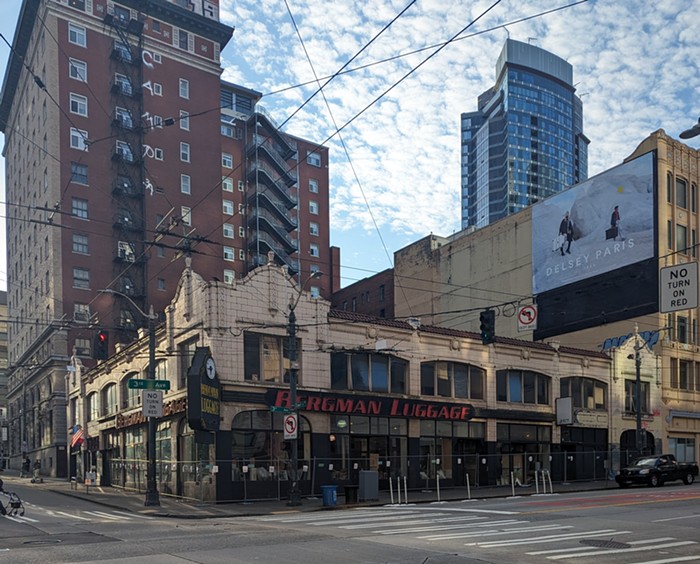
I could feel everyone turning to look at me as I zoomed down the bike lane on Broadway, the speaker on my bulky orange scooter proudly emitting a nonstop “cha-ching” bike-bell noise like I was leading a one-man parade. This is the future of Seattle scooter-share technology.
The next generation of Spin scooters, now already being rolled out, comes equipped with hardware that can detect where you’re riding — sidewalk, street, or bike lane — and they’ll sound an alarm based on what they perceive. Spin’s not the only company working on this tech; Wheels is planning a similar feature for their next fleet of ebikes.
The goal is to improve safety and reduce pedestrian collisions, says Kyle Rowe, Global Head of Government Partnerships at Spin. (He previously worked on mobility programs at the Seattle Department of Transportation.) I met Kyle this morning by the Capitol Hill light rail station to take the new models for a test ride, and to see if this new technology actually does what its makers claim.
I was skeptical.
“Across the US, the primary unintended impact of bringing scooter shares to cities … is sidewalk riding,” Kyle said, standing by Spin’s new state-of-the-art model.
I’m willing to accept that sidewalk riding does occur, though there’s not much data to back up the assertion that it’s really a threat — at least not yet. Scooters are so new to US cities, and so limited in their adoption, that we’re probably still a year or two away from having useful data about sidewalk-riding in Seattle.
But Spin has shrewdly gotten ahead of the frequent complaint that scooters are unsafe. (The last time I wrote about the subject, I got an email complaining that only poor people and children use scooters — which is both classist and untrue, congratulations.)
Will these new high-tech scooters solve our transportation problems? If nothing else, they certainly solve the problem of my hands getting numb from the vibration caused by our uneven pavement. The new Spin models have heavy-duty shocks and nice thick wheels that make for a surprisingly smooth ride, a noticeable improvement over Lime scooters. Another plus: Spin’s scooters have swappable batteries, so maintenance teams no longer need to haul drained scooters down to a maintenance station for a recharge.
And when it comes to sidewalk detection, the experience is … well, it’s mixed.
I expected them to be flummoxed by Barbara Bailey Way, one of Seattle’s new curbless streets, but the scooter was able to tell that it was on a street despite the pavement being sidewalk-colored. Then as soon as we crossed the bumpy strip that delineates the pedestrian area, the scooter’s alarm started to warble, as it is designed to do. Riding the scooter up onto a sidewalk caused it to immediately sing the song of its people — kind of a “robot learning to yodel” noise, not a harsh sound, but still not a pleasant accompaniment.
Next, we headed down Broadway in the bike lane, and discovered that the scooter loves bike lanes. It produced a happy “cha-ching” sound every few seconds, and because nobody is used to these things yet, it looked to everyone around me like I was responsible for producing the sound like some kind of weirdo flirting with everyone in sight.
There is, at least, some benefit to this: At one point, two delivery guys were blocking the bike lane, and they quickly moved out of the way as I noisily approached.
But it can also be a little uncomfortable to be attached to a giant noise-making device. One street that I encountered was closed for construction, so I walked the scooter up onto the sidewalk. Even though I was walking, the alarm still yodeled — maybe because the scooters haven’t been trained to understand that gay people walk faster than straights — and the construction workers certainly took an interest in what I was doing. “Sorry, sorry, sorry, it just does that,” I said as I hurried by, keenly aware that I must have looked like I’d stolen the thing.
A few segments of the Broadway bike lane caused confusion, with the scooter switching rapidly back and forth between understanding where it was and thinking that it was on the sidewalk; it seemed to be confused by the raised curbs separating the bike lane from car traffic. I didn’t have an opportunity to take it down Yesler, but I have a feeling that several of those segments would cause similar flummoxing.
The scooter was also dismayed when we reached Union and Madison, where the bike lane ends and directs riders up onto the sidewalk. As expected, the alarm sounded — but that’s really the city’s fault for building such a mess of an intersection, with five streets converging together. In a few years, the whole thing will be overhauled with bus lanes and fewer cars, but until then the Spin scooters will have to endure a brief ride on the sidewalk. (Kyle says that they might geofence certain areas in the scooters’ brains so that they understand that in a few limited areas, sidewalk-riding is okay.)
Getting the tech to work properly is a learning process, both for the scooters and for their human caretakers. According to Kyle, the sidewalk-detection is 80% algorithmic and 20% training; when the scooters are introduced to a new area, engineers ride around with a training device to “teach” them where they are and aren’t allowed to go.
For now, the Spin scooters are primarily in West Seattle, with a gradual expansion planned across the city. I’ve enjoyed using Lime to get around, but all too often I find the batteries running on empty and unable to make the climb up to Capitol Hill. If Spin, with their smoother ride, can deploy enough of the vehicles and swap out the batteries fast enough, I’ll be tempted to end my Lime subscription and switch to Spin.
The only thing holding me back is the scooters’ unpredictable confusion and uncontrollable noises. It felt a bit like riding around with a cartoon sound effect board strapped to my back — I never knew when my ride would suddenly produce a loud warbling call.
But I understand why this might just be something we have to live with, at least for the time being. As a new-ish form of transportation, there will inevitably be resistance to scooters — as if cars aren’t ten billion times worse — and if this goofy technology helps calm the complaints, sure, fine, I guess I can endure it as we transition to a post-automobile world. The fewer excuses that cities have to ban scooters, the better.
As we stood at Madison and Union, watching hundreds of metal death-machines roar past, Kyle noted that making transportation more sustainable will require that micro-mobility companies find creative ways to prove themselves to gatekeepers in city government.
“Cities hold the keys,” he said.



















